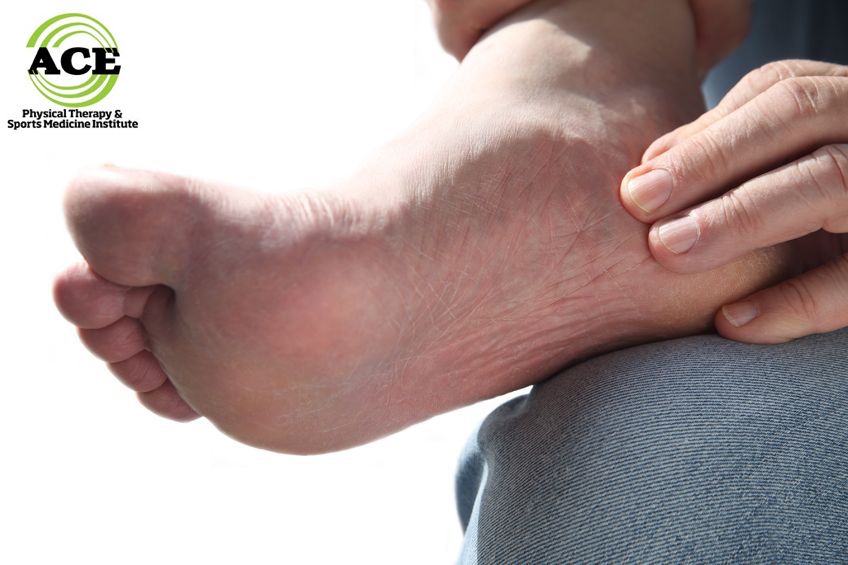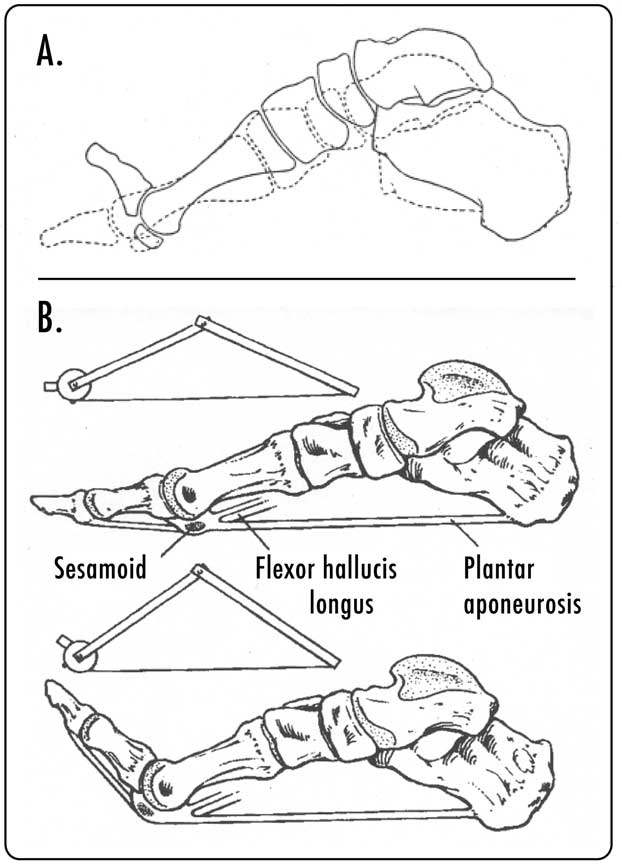WINDLASS MECHANISM OF THE FOOT

Tid Bits of Info
- A windlass is a tightening of a rope or cable around a pivot point.
- The plantar fascia is the “cable” and the metatarsal heads are the pivot point.
- Plantar fasciitis is characterized with sharp pain on the bottom of the heel especially during the first steps in the morning.
- In most cases, combining a comprehensive lower extremity exercise program and “over-the counter” orthotics will eliminate the symptoms of plantar fasciitis.
- Seek the advice and treatment of a Physical Therapist is you have foot pain.
Every day the feet carry our weight through a series of activities. Standing and moving on our feet puts a tremendous amount of stress and strain on each foot. As we walk, run and move, the bones and joints of the foot and ankle complex must be stable when the foot hits the ground and pushes the body through space.
Human gait mechanics involve the rigidity of the foot and ankle when the foot hits the ground and at toe or push off and the foot’s ability to become somewhat supple at mid-stance to absorb stress of the body weight. The mid-stance position enables the foot to protect the lower extremity from impact type injuries. The problem arises when the foot is unable to transition from the mid-stance, flat foot position to the rigid, heel off the ground push off position.
A person with a “flat foot” is diagnosed with excessive pronation. The person that has a “high-arch” is categorized as a “supinator”. Both conditions can cause pain within the foot, ankle and entire lower extremity if they are not controlled. The foot and ankle are constructed in a way that stability is intrinsic with the design. The ability to push off one’s entire body weight with one foot is dependent upon many factors. The lower extremity muscle strength is the primary factor, but the transition from a supple mid-stance to a rigid push-off or toe-off is greatly aided by the plantar fascia.
The plantar fascia is a thick, leather-like band of connective tissue that spans the bottom or plantar surface of the foot. The band attaches to the heal bone (calcaneus) and stretches across the mid-tarsal bones to the ends of the metatarsals. The plantar fascia inserts into the flexor tendons of the toes. When the toes are moved into a dorsiflexed position (movement toward the shin bone) the plantar fascia is “wrapped” around the metatarsal heads. The Great toe or Big toe is the primary site of this occurrence. This “wrapping” is referred to as the windlass mechanism of the foot. The term is taken from the sailing world because the winch mechanism wraps the rope around a drum to move the sail.
The windlass mechanism in the foot enables the foot to support the body weight and move it through space. When the foot transition from mid-stance to toe off, the toes move from a plantar flexed or neutral position to a dorsiflexed position. The dorsiflexion of the toes produces the windlass mechanism utilizing the plantar fascia. The “wrapping” of the plantar fascia around the metatarsal heads “pulls” the calcaneus towards the toes. The mid tarsal arches raise up off the ground and the foot transitions from a supple, pronated position to rigid, supinated position. The rigidity of the foot is needed to become a lever that is capable of propelling someone as they walk.
If there is damage to the plantar fascia or the anatomy of the foot does not allow the windlass mechanism to function, the energy needed to walk rises significantly. Many times the person will walk with a limp due to the lack of push off power. The foot and ankle are more unstable and are susceptible to injuries.
If you are having heel pain or pain in your foot/feet you should seek the advice of a Physical Therapist. They are highly educated healthcare professionals that specialize in function. They are able to evaluate your condition and treat it. They will evaluate the way you walk or run and make suggestions as to how you might have to change your mechanics to avoid injuries. They can show you numerous exercises that will involve the entire lower extremity.
Weakness in the hips can lead to excessive pronation in the foot at the mid-stance position. The excessive pronation can make the windlass mechanism non-functional. They might suggest that you get a pair of “over-the-counter” orthotics or inserts for your shoes. These inserts should be hard plastic to help support the arches and reduce the strain on the plantar fascia. In some cases, the Physical Therapist might fabricate a pair of “custom” orthotics that is specially designed for your feet. The Physical Therapist might refer you to a podiatrist if they do not provide these services. The Physical Therapist can treat your symptoms and help you return to pain-free status when you walk or run.
Seeking the advice and treatment of a Physical Therapist is easy and does not require you to visit your doctor first. Your insurance company might require that you obtain a referral form from your primary care physician, you do not need a doctor’s prescription to seek treatment from a Physical Therapist. These well- educated healthcare professionals are first line providers and will manage your condition. If they think that you need further diagnostic testing they will refer you to the qualified professionals.
The foot and ankle are under a tremendous amount of stress and strain throughout the day. The complex must support the person’s body weight without being injured. The ability of the foot and ankle to support and move one’s body through space is partially dependent upon the windlass mechanism of the plantar fascia. A healthy plantar fascia enables the foot and ankle to move someone through space without pain and without excessive energy expenditure.


























Having torn my plantar fascia, I really have to go after strengthening my hip musculature especially if I want to be running or going on long walks. I can definitely feel the negative effects on my foot when I am not doing my stabilization exercises. It’s nice to have these experiences that I am able to share with patients that help them get a little bit more on board with what I am saying.